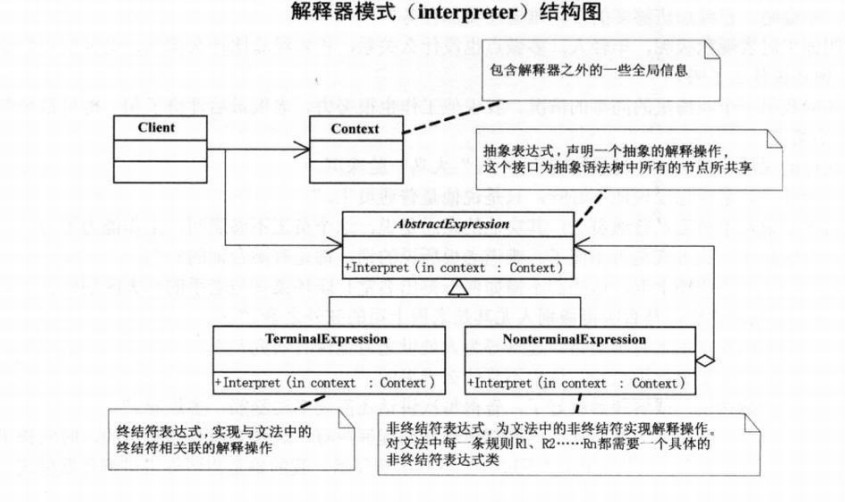解释器模式:给定一个语言,定义他的文法的一种表示,并定义一个解释器,这个解释器用于解释语言中的句子。比如文件解密

按如下规则编写程序:

演奏内容类(Context)

using System; using System.Collections.Generic; using System.Linq; using System.Text; namespace InterpreterPattern.CLASS { //需要解释的文本 class Context { private string text; public string Text { get { return text; } set { text = value; } } } }
解释器类(AbstractExpression)

using System; using System.Collections.Generic; using System.Linq; using System.Text; namespace InterpreterPattern.CLASS { //解释器 abstract class AbstractExpression { public void Interpreter(Context context) { if (context.Text.Length == 0) { return; } else { string key = context.Text.Substring(0, 1); context.Text = context.Text.Substring(2); //indexOf() 方法可返回某个指定的字符串值在字符串中首次出现的位置。 double value = Convert.ToDouble(context.Text.Substring(0, context.Text.IndexOf(" "))); context.Text = context.Text.Substring(context.Text.IndexOf(" ") + 1); Excute(key, value); } } public abstract void Excute(string key, double value); } }
终结符表达式类(TerminalExpression)

using System; using System.Collections.Generic; using System.Linq; using System.Text; namespace InterpreterPattern.CLASS { //音节类 class TerminalExpreesion : AbstractExpression { public override void Excute(string key, double value) { string note = ""; switch (key) { case "C": note = "1"; break; case "D": note = "2"; break; case "E": note = "3"; break; case "F": note = "4"; break; case "G": note = "5"; break; case "A": note = "6"; break; case "B": note = "7"; break; default : break; } Console.Write("{0} ", note); } } }
终结符表达式1类(TerminalExpression)

using System; using System.Collections.Generic; using System.Linq; using System.Text; using System.Reflection; namespace InterpreterPattern.CLASS { //音符类 class TerminalExpression1:AbstractExpression { public override void Excute(string key, double value) { string scale = ""; switch (Convert.ToInt32(value)) { case 1: scale = "低音"; break; case 2: scale = "中音"; break; case 3: scale = "高音"; break; default: break; } Console.Write("{0} ", scale); } } }
测试类(TestMain)

using System; using System.Collections.Generic; using System.Linq; using System.Text; using InterpreterPattern.CLASS; namespace InterpreterPattern { class TeatMain { static void Main(string[] args) { Context context = new Context(); Console.WriteLine("上海滩:"); context.Text = "O 2 E 0.5 G 0.5 A 3 E 0.5 G 0.5 D 3 E 0.5 G 0.5 A 0.5 O 3 C 1 O 2 A 0.5 G 1 C 0.5 E 0.5 D 3 "; AbstractExpression expression = null; try { while (context.Text.Length > 0) { string str = context.Text.Substring(0, 1); switch (str) { case "O": expression = new TerminalExpression1(); break; case "C": case "D": case "E": case "F": case "G": case "A": case "B": case "P": expression = new TerminalExpreesion(); break; } expression.Interpreter(context); } } catch(Exception e) { Console.WriteLine(e.Message); } Console.Read(); } } }
测试结果:

